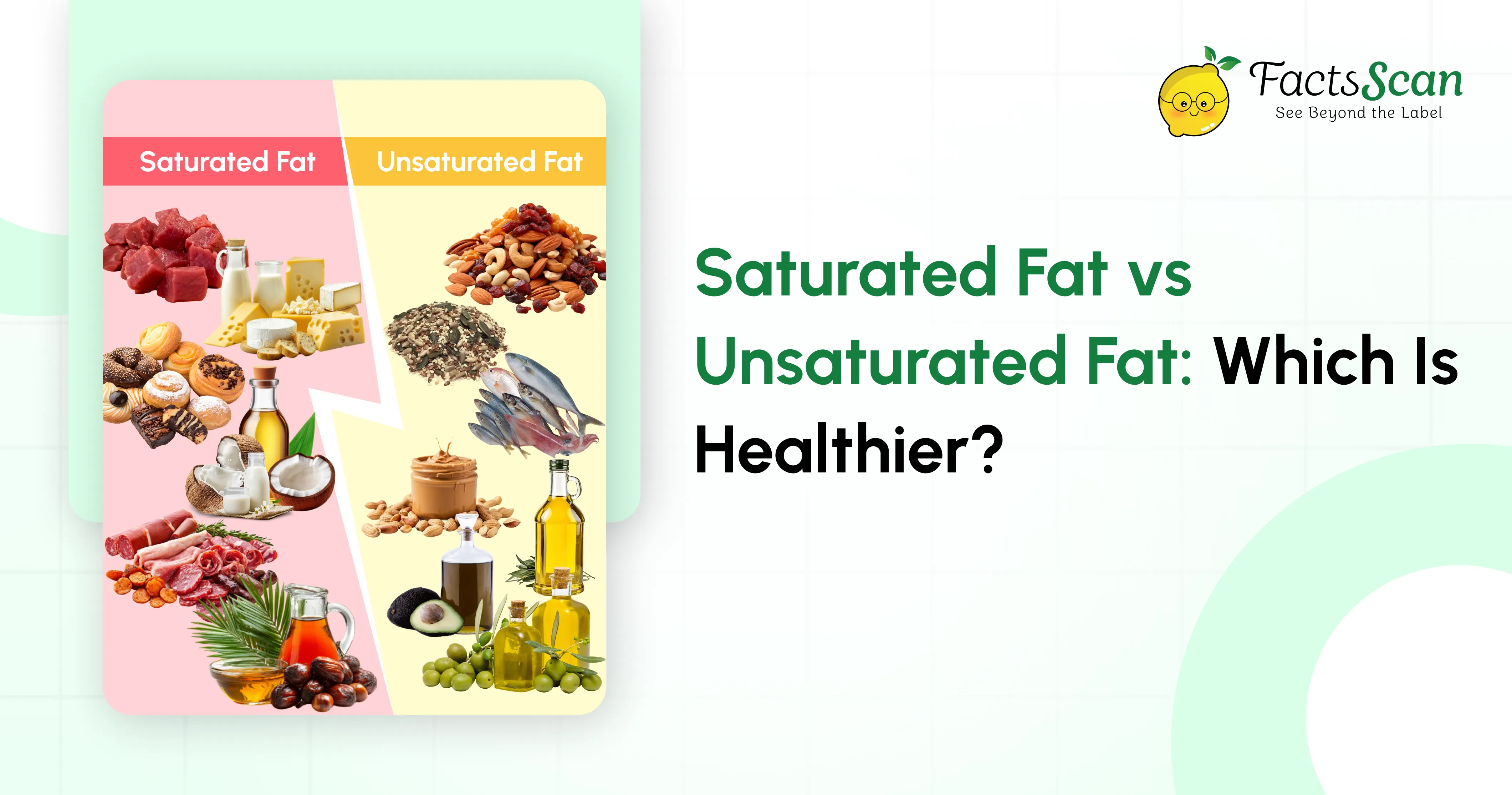Saturated Fat vs Unsaturated Fat: Which Is Healthier?
Summary :
Saturated and unsaturated fats affect our health in different ways. While saturated fats—commonly found in meat, butter, and full-fat dairy—can increase cholesterol levels, unsaturated fats, present in nuts, seeds, and vegetable oils, help improve heart health. Prioritizing unsaturated fats over saturated ones can lead to better overall wellness.
Walk into any grocery store today, and you’ll see labels screaming “low-fat,” “heart-healthy oils,” and “zero trans fats.” Meanwhile, your social media feed tells you butter is back and seed oils are toxic. So what’s the truth about fats? Are they friend or foe?
Here’s the reality: not all fats are created equal, and understanding the difference between saturated and unsaturated fats can transform how you eat and feel. This isn’t about eliminating entire food groups or following the latest diet trend. It’s about making informed choices that support your health while still enjoying delicious food.
In this guide, we’ll break down everything you need to know about saturated and unsaturated fats in language that actually makes sense, without the confusing science jargon or conflicting advice.
What Exactly Are Fats and Why Do They Matter?
Fats are one of the three macronutrients your body needs to function, alongside carbohydrates and proteins. Think of them as essential building blocks that your body uses for energy, hormone production, brain function, and absorbing vitamins A, D, E, and K.
Your body can’t make certain fats on its own, which means you must get them from food. Fats also make food taste better and keep you feeling full longer, which is why that salad with olive oil dressing satisfies you more than plain lettuce.
The catch? The type of fat you eat matters tremendously for your health. Some fats protect your heart and reduce inflammation, while others can increase your risk of cardiovascular disease when consumed in excess.
Understanding Saturated vs Unsaturated Fats
1. The Chemistry Made Simple
At the molecular level, the difference comes down to chemical bonds, but you don’t need a chemistry degree to understand this.
Saturated fats are “saturated” with hydrogen atoms. Their chemical structure has no double bonds between carbon atoms, making them solid at room temperature. Think of butter sitting on your counter or the white fat on a steak that hardens as it cools.
Unsaturated fats have one or more double bonds in their structure, with fewer hydrogen atoms attached. This makes them liquid at room temperature, like olive oil or the oil in a can of tuna.
Unsaturated fats come in two varieties:
Monounsaturated fats have one double bond. Foods like olive oil, avocados, and almonds are rich sources.
Polyunsaturated fats have multiple double bonds and include essential omega-3 and omega-6 fatty acids that your body cannot produce. These are found in fatty fish, walnuts, flaxseeds, and sunflower oil.
2. Real Food Examples
1. Saturated Fat Sources:
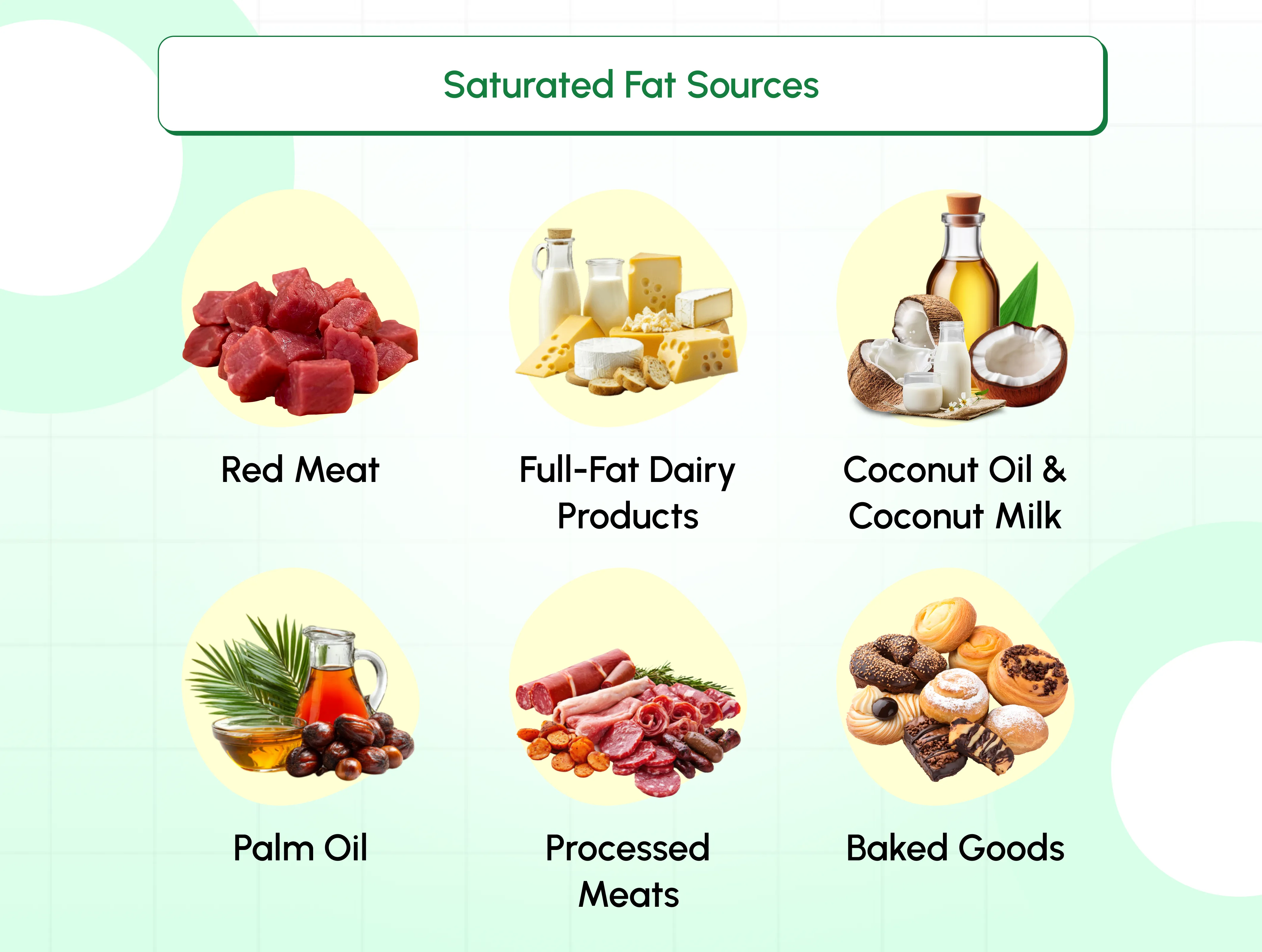
- Red meat (beef, lamb, pork)
- Full-fat dairy products (butter, cheese, whole milk, cream)
- Coconut oil and coconut milk
- Palm oil
- Processed meats (sausages, bacon, salami)
- Baked goods and pastries made with butter or shortening
2. Unsaturated Fat Sources:
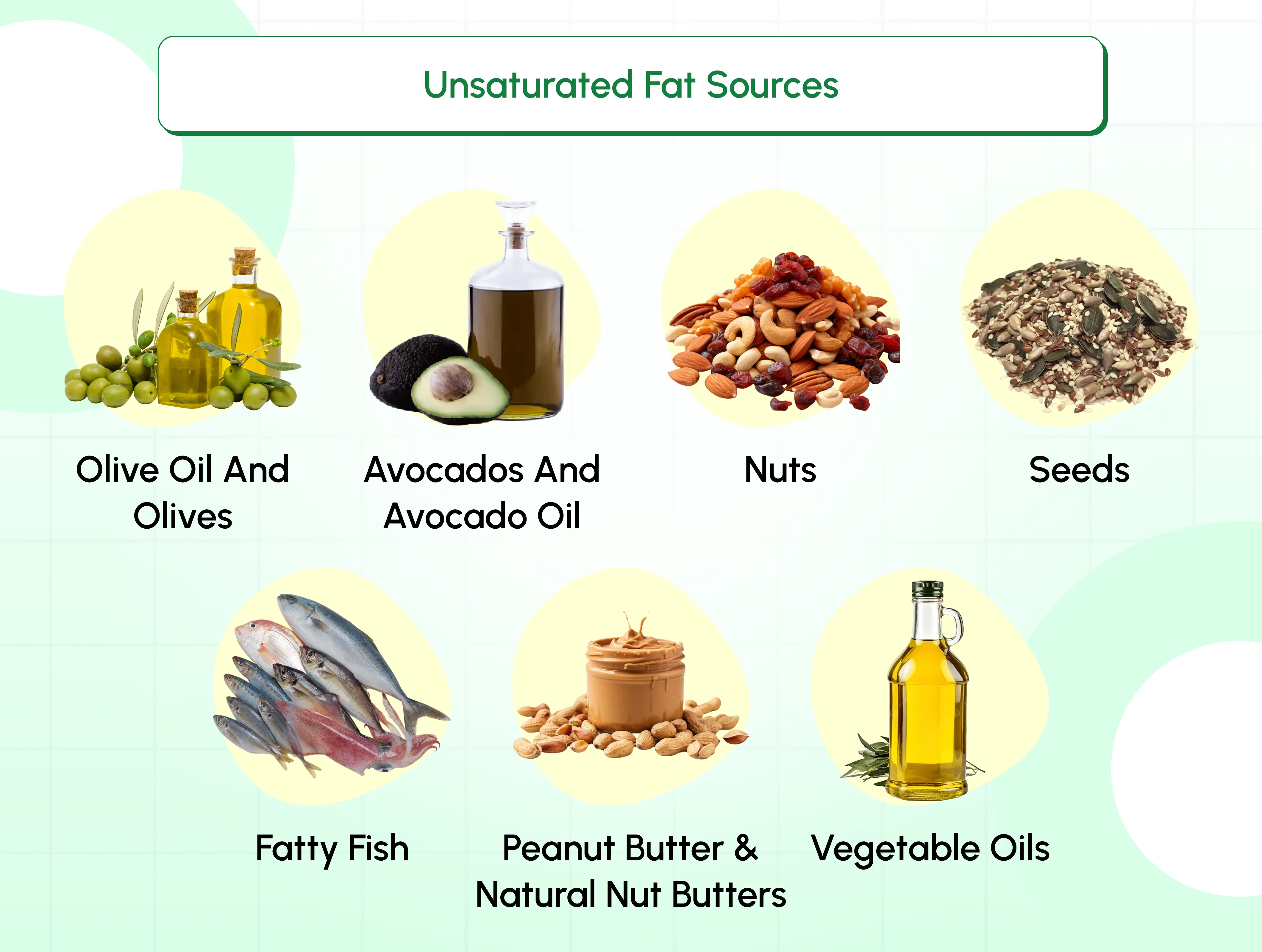
- Olive oil and olives
- Avocados and avocado oil
- Nuts (almonds, cashews, walnuts, pistachios)
- Seeds (chia, flax, sunflower, pumpkin)
- Fatty fish (salmon, mackerel, sardines, herring)
- Peanut butter and natural nut butters
- Vegetable oils (canola, sunflower, safflower)
How These Fats Impact Your Health
1. Cholesterol and Your Cardiovascular System
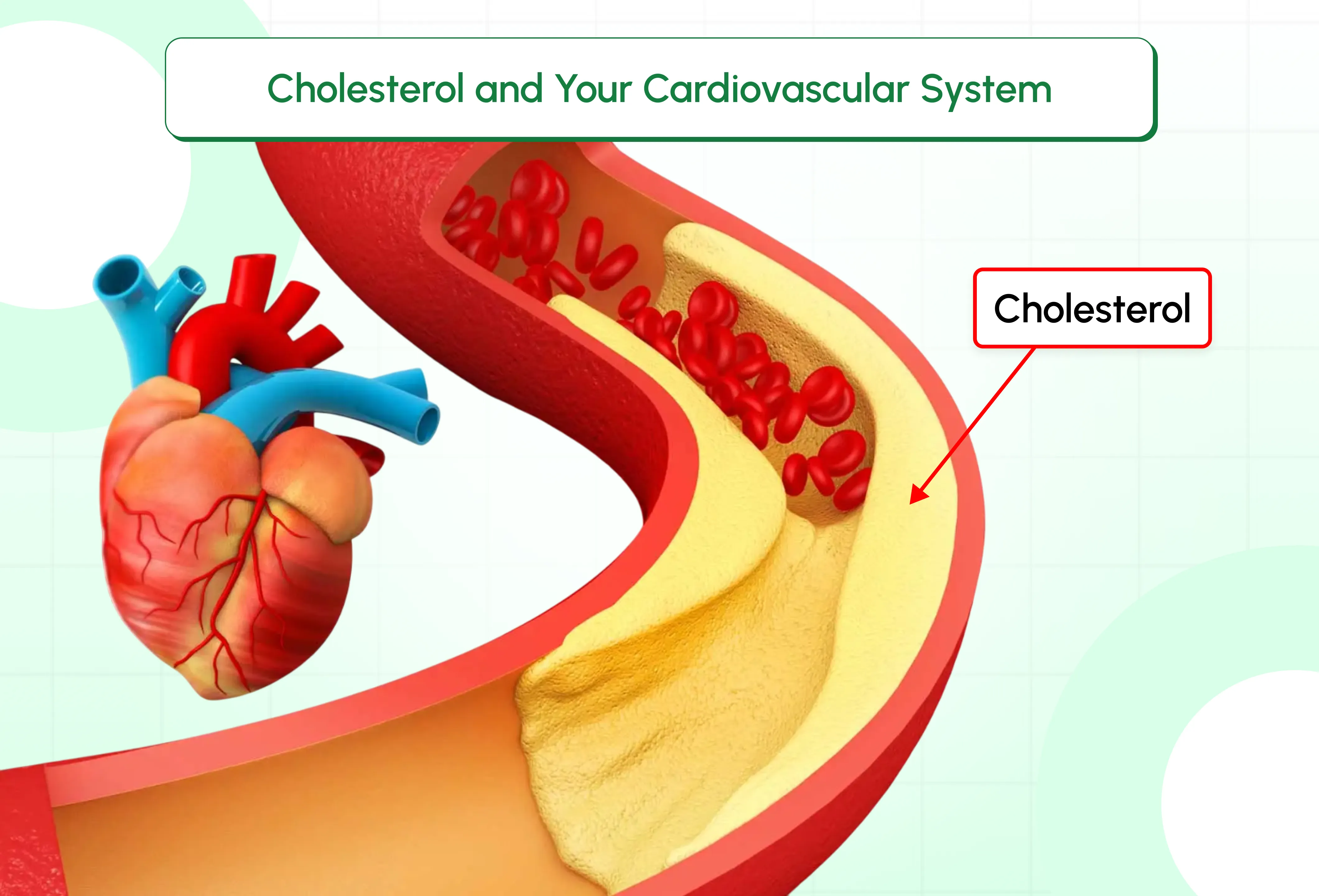
Here’s where things get interesting. Your body produces cholesterol naturally because you need it for cell membranes and hormone production. But the type of fat you eat influences your cholesterol levels, particularly LDL (often called “bad” cholesterol) and HDL (“good” cholesterol).
Saturated fats raise both LDL and HDL cholesterol. The problem is that elevated LDL cholesterol contributes to plaque buildup in your arteries, increasing the risk of heart disease and stroke. When LDL particles accumulate in artery walls, they trigger inflammation and narrow blood vessels, making it harder for blood to flow freely.
Unsaturated fats, particularly monounsaturated and polyunsaturated fats, work differently. They can help lower LDL cholesterol while maintaining or even raising HDL cholesterol. HDL acts like a cleanup crew, carrying excess cholesterol away from your arteries back to your liver for disposal.
Studies show that replacing saturated fats with unsaturated fats reduces cardiovascular disease risk more effectively than simply cutting total fat intake. It’s not just about eating less fat, it’s about eating better fats.
2. Inflammation and Beyond
Chronic inflammation is like a slow-burning fire in your body, linked to heart disease, diabetes, arthritis, and even certain cancers. The fats you eat can either fuel this fire or help put it out.
Omega-3 fatty acids, found in fatty fish, walnuts, and flaxseeds, have powerful anti-inflammatory properties. They help reduce inflammation markers in your blood and support brain health, potentially lowering the risk of cognitive decline.
Saturated fats, especially when consumed in large amounts, may promote inflammation. However, the source matters. Saturated fat from processed meats appears more harmful than saturated fat from dairy products like yogurt or cheese.
Trans fats, which are artificially created unsaturated fats, are the absolute worst for inflammation and health. Thankfully, many countries have banned or restricted them in food products.
Common Myths and Misconceptions
1. The Coconut Oil Hype
Coconut oil became a health food darling in recent years, with claims that it boosts metabolism, fights infections, and improves brain function. The reality is more nuanced.
Coconut oil is approximately 90 percent saturated fat, higher than butter or lard. While it does contain medium-chain triglycerides that your body metabolizes differently than other fats, most coconut oil is still long-chain saturated fat that raises LDL cholesterol.
The American Heart Association reviewed the evidence and concluded that coconut oil raises LDL cholesterol similarly to other saturated fats. It’s not poison, but it’s not a superfood either. Use it occasionally for flavor, but don’t make it your primary cooking oil.
2. The Seed Oil Debate
Online wellness influencers often claim that seed oils like canola, sunflower, and soybean oil are “inflammatory” and should be avoided. This oversimplifies complex science.
These oils are high in omega-6 fatty acids. While excessive omega-6 relative to omega-3 intake might promote inflammation, most people’s inflammation issues stem from overall poor diet quality, excess calories, and processed foods, not specifically from these oils.
Refined seed oils aren’t nutritional powerhouses, but they’re not dietary villains either. The key is balance. Use a variety of oils, emphasize omega-3 sources, and focus on whole foods rather than obsessing over specific oils.
3. Low-Fat Food Confusion
The low-fat craze of the 1990s led food manufacturers to create thousands of low-fat products. The problem? They often replace fat with sugar and refined carbohydrates, making these products potentially worse for your health than the full-fat versions.
Low-fat cookies, yogurts, and salad dressings often contain added sugars to improve taste. These added sugars spike blood glucose, promote weight gain, and increase inflammation. Sometimes the full-fat version with less sugar is the healthier choice.
Fat isn’t inherently fattening. Excess calories from any source lead to weight gain. Quality fats actually help you feel satisfied and can prevent overeating.
Official Guidelines and Recommendations
1. What the Experts Say
The World Health Organization recommends that saturated fats should make up less than 10 percent of your total daily energy intake. For someone eating 2,000 calories per day, that’s about 22 grams or roughly 200 calories from saturated fat.
The American Heart Association is even stricter, suggesting limiting saturated fat to 5-6 percent of total calories. For that same 2,000-calorie diet, that means no more than 13 grams or 120 calories from saturated fat daily.
Both organizations recommend replacing saturated fats with unsaturated fats rather than refined carbohydrates. This distinction is crucial because swapping saturated fat for white bread or sugary foods won’t improve your health.
2. Understanding the Numbers
To put these recommendations in perspective:
- One tablespoon of butter contains about 7 grams of saturated fat.
- A 100-gram serving of cheddar cheese has approximately 21 grams of saturated fat.
- A single burger patty might contain 8-12 grams of saturated fat.
- Three slices of bacon provide roughly 9 grams of saturated fat.
You can see how saturated fat adds up quickly, especially if you’re eating multiple sources throughout the day. This doesn’t mean you can never enjoy these foods, but awareness helps you make balanced choices.
Practical Tips for Everyday Eating
1. Smart Food Swaps
Making small substitutions can significantly improve your fat intake without sacrificing flavor:
Instead of butter on toast, try mashed avocado with a pinch of salt and pepper. You’ll get creamy richness plus fiber and potassium.
Swap full-fat dairy for plant-based alternatives in smoothies and coffee. Unsweetened almond or oat milk reduces saturated fat while adding different nutrients.
Choose fish over red meat twice weekly. Salmon, mackerel, or sardines provide omega-3s that beef can’t match.
Use olive oil for cooking instead of butter or coconut oil. Extra virgin olive oil adds flavor and heart-healthy monounsaturated fats.
Snack on nuts instead of chips or cookies. A small handful of almonds or walnuts provides a satisfying crunch with beneficial fats, protein, and fiber.
Replace mayo with Greek yogurt in chicken salad or tuna salad. You’ll cut saturated fat while boosting protein.
2. Cooking Oil Guidance
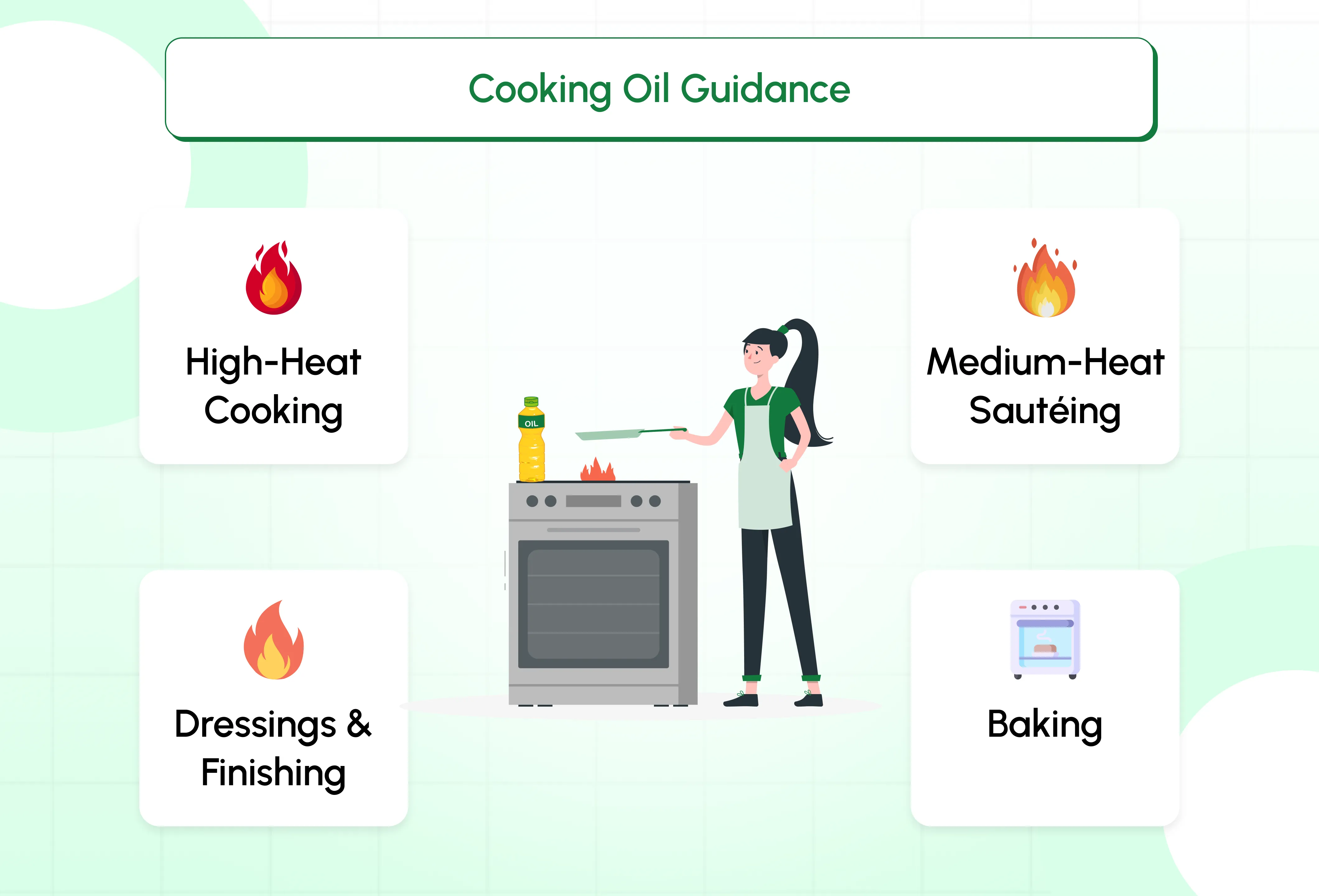
Different oils work better for different cooking methods:
- For high-heat cooking: Like stir-frying or roasting, use avocado oil or refined olive oil. They have higher smoke points and won’t break down.
- For medium-heat sautéing: Extra virgin olive oil or canola oil work well and add flavor.
- For dressings and finishing: Use extra virgin olive oil, walnut oil, or flaxseed oil. Their delicate flavors shine when used raw.
- For baking: Try substituting some butter with unsweetened applesauce or mashed banana to reduce saturated fat while keeping moisture.
3. Portion Control Matters
Even healthy fats are calorie-dense at 9 calories per gram. Practice these portion guidelines:
- Cooking oils: 1-2 tablespoons per meal
- Nuts and seeds: A small handful (about 30 grams) as a snack
- Avocado: ¼ to ½ of a medium fruit per serving
- Nut butter: 1-2 tablespoons spread on toast or mixed in oatmeal
4. Reading Food Labels Like a Pro
When scanning packaged foods, check the nutrition facts panel:
Look at total fat and break down the saturated fat content. If saturated fat makes up more than half the total fat, consider it a high saturated fat food.
Check the serving size carefully. That bag of chips might look reasonable until you realize it contains 2.5 servings.
Scan the ingredient list for “partially hydrogenated oils,” which indicate trans fats. Even if the label says “0g trans fat,” products can contain up to 0.5 grams per serving and still make this claim.
Compare similar products side by side. Different brands of similar foods can have dramatically different fat profiles.
5. Finding Balance for Your Health
The bottom line isn’t that saturated fat is poison and unsaturated fat is perfect. It’s about balance, context, and overall dietary patterns.
Most healthy eating patterns like the Mediterranean diet naturally emphasize unsaturated fats from olive oil, fish, nuts, and seeds while including moderate amounts of saturated fat from cheese and yogurt. These patterns consistently show benefits for heart health, longevity, and disease prevention.
You don’t need to eliminate saturated fat completely. A piece of cheese on your sandwich or butter on your occasional baked potato won’t derail your health. The problems arise when saturated fat dominates your diet through daily consumption of processed meats, fried foods, and heavy cream sauces.
Focus on these key takeaways:
- Emphasize unsaturated fats from whole food sources like nuts, seeds, avocados, and fatty fish.
- Limit saturated fat to less than 10 percent of daily calories.
- Replace saturated fats with unsaturated fats rather than refined carbohydrates.
- Avoid trans fats entirely by checking labels.
- Choose minimally processed foods and cook at home when possible.
- Remember that overall diet quality matters more than any single nutrient.
Making healthier choices about fats doesn’t have to be complicated. Whether you’re shopping for groceries or preparing meals, the right tools can make all the difference.
Download and use the FactsScan app to instantly check if any packaged food is healthy for you and your family. Simply scan the barcode on any product, and FactsScan analyzes its ingredients and nutritional content, giving you clear, personalized recommendations in seconds. Take the guesswork out of healthy eating and make every food choice count. Your heart will thank you.
Ready to make Healthier Choices?
Download FactsScan now from the Google Play Store and App Store and take charge of your food choices.

Recent Articles

Hidden Sugars in Packaged Foods: 50+ Names You Must Know Before Buying
Uncover the shocking truth about hidden sugars lurking in everyday packaged foods. Learn why manufacturers add them, understand the serious health risks, and master the skill of identifying over 50 disguised sugar names on ingredient labels to protect your health.

How to Identify Organic Food in India: A Complete Consumer Guide
Discover how to confidently identify genuine organic food in India. Learn about certifications, label reading, and effective ways to verify authenticity using simple, actionable steps for your everyday shopping.
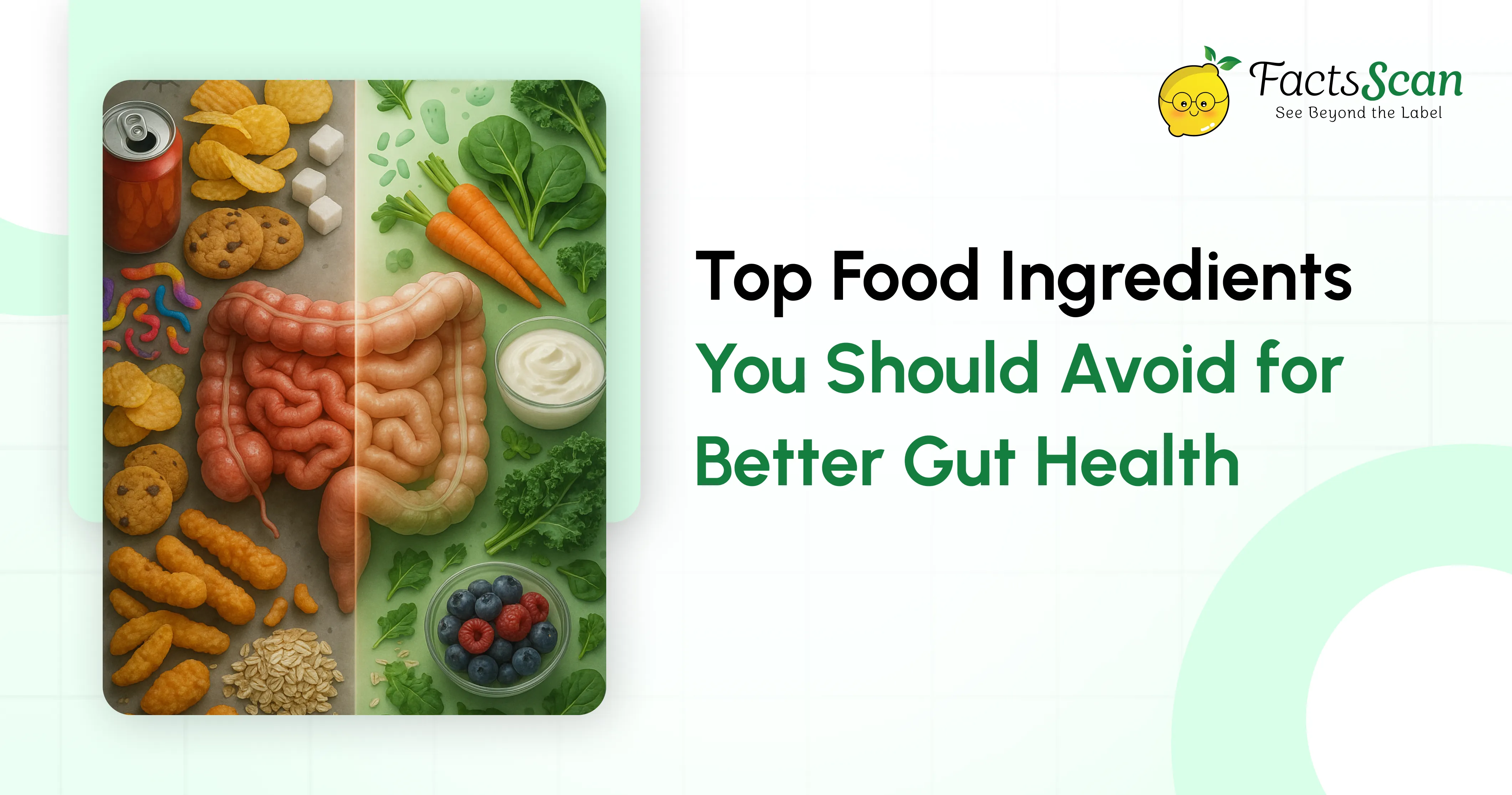
Top Food Ingredients You Should Avoid for Better Gut Health
Your gut microbiome is the foundation of your overall wellness, affecting everything from digestion to immune function. Yet many everyday food ingredients—artificial sweeteners, refined oils, emulsifiers, and preservatives—are slowly damaging this delicate ecosystem. Learn which harmful ingredients to eliminate from your diet and discover healthier alternatives using smart tools to identify nutritious, gut-friendly options that truly support your digestive health and long-term wellbeing.
 15 Oct 2025
15 Oct 2025 11 Min Read
11 Min Read 
